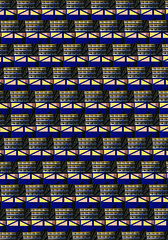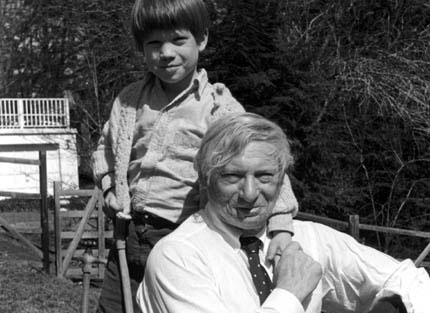
If there was anything about math that I had vaguely liked, it was geometry.
There is something about the order, balance, symmetry, form and pattern in geometry that is pleasurable, even poetic. Maybe because these are qualities mirrored in nature, with its own bag of patterns and form, its own rhythmns, cycles and hierarchies that order life. If nature is the work of a perfect Creator, then in art - man's creative outcome - the principles of geometry have often held both their aesthetic and spiritual grounds on what could be considered perfect or beautiful.
I finally watched the Louis Kahn documentary My Architect that L had passed to J some time ago and had J talking about Louis Kahn virtually non-stop for days. Like J, I too had these scenes, images and ideas from the documentary that refused to leave my mind. And if there's a word to sum up these post-viewing thoughts, it would probably be geometry.
 The documentary was made by 1 of 2 illegitimate children that Kahn had. Nathaniel Kahn knew his father through weekly visits up until his death when the filmmaker was 11. As such, his search and quest to understand his late father forms the other narrative of the documentary. For all the order and public monumentality of Kahn's most famous buildings that the filmmaker's eyes (and camera) scan, these views are balanced by the seeming disorder of the relationships in the intensely private personal life of the architect. And in a relationship between parent and child - a relationship not by choice, a relationship of inheritance and hence repetition/pattern - the need for order All of this makes the narrative of Nathaniel Kahn's search for his father among his work all the more poignant.
The documentary was made by 1 of 2 illegitimate children that Kahn had. Nathaniel Kahn knew his father through weekly visits up until his death when the filmmaker was 11. As such, his search and quest to understand his late father forms the other narrative of the documentary. For all the order and public monumentality of Kahn's most famous buildings that the filmmaker's eyes (and camera) scan, these views are balanced by the seeming disorder of the relationships in the intensely private personal life of the architect. And in a relationship between parent and child - a relationship not by choice, a relationship of inheritance and hence repetition/pattern - the need for order All of this makes the narrative of Nathaniel Kahn's search for his father among his work all the more poignant. You could say that there is a similar pattern of contradiction yet beauty in Kahn's works. For all the austerity and grand scale of Kahn's works, they seem (at least to my untrained eyes) premised on the simple geometry of forms and planes - a circle, a triangle, a square, their intersections - and by extension, the geometry of nature in play with the structures. There is seldom any ornamentation. Instead, there is only the space itself, or the patterns inherent in nature/materials or the process of creation, or the forms and patterns and sense of space created by the falling or bodies of water.
You could say that there is a similar pattern of contradiction yet beauty in Kahn's works. For all the austerity and grand scale of Kahn's works, they seem (at least to my untrained eyes) premised on the simple geometry of forms and planes - a circle, a triangle, a square, their intersections - and by extension, the geometry of nature in play with the structures. There is seldom any ornamentation. Instead, there is only the space itself, or the patterns inherent in nature/materials or the process of creation, or the forms and patterns and sense of space created by the falling or bodies of water. What more, for the cold austerity and grand scale of Kahn's works, they also appear to have touched individuals at a personal and almost spiritual level. The documentary ends, for instance, with Kahn's last work - Bangladesh's parliamentary building in the capital Dhaka. (R above- photo by Karl E Roehl). The interviews with the Bangladeshi architects who had worked with Kahn on the project were strangely very moving. Both in fact spoke with tears in their eyes! After all, it was on Kahn's return journey from a working visit for this project (the buildings were completed some 9 years after Kahn's death) that he died of a heart attack in a train station and lay unclaimed in the city morgue for 3 days since the address in his passport was deliberately crossed out.
What more, for the cold austerity and grand scale of Kahn's works, they also appear to have touched individuals at a personal and almost spiritual level. The documentary ends, for instance, with Kahn's last work - Bangladesh's parliamentary building in the capital Dhaka. (R above- photo by Karl E Roehl). The interviews with the Bangladeshi architects who had worked with Kahn on the project were strangely very moving. Both in fact spoke with tears in their eyes! After all, it was on Kahn's return journey from a working visit for this project (the buildings were completed some 9 years after Kahn's death) that he died of a heart attack in a train station and lay unclaimed in the city morgue for 3 days since the address in his passport was deliberately crossed out. A man who spent his life creating spaces with a sense of place dies without an address, alone despite having 3 families, and bankrupt despite the wealth of meaning he has created for the users of his buildings. If irony had a geometric value, one could call it a dark symmetry.
Comments